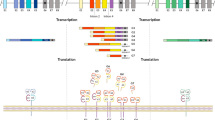Abstract
A.BY, B10.LPa, and B10.129(5M) mice were presensitized in vivo against B10.A(5R) cells and then restimulated in vitro by the same cells in the standard CML assay. The effector cells thus generated lysed not only B10.A(5R), but also C57BL/6 targets, indicating that, in addition to anti-H-2Dd response [measured on the B10.A(5R) targets], response to minor histocompatibility (H) antigens (measured on the C57BL/6 targets) also occurred. The latter response was directed against multiple minor H antigens in the case of the A.BY effectors, and against H-1 and H-3 antigens in the case of B10.129(5M) and B10.LPa effectors, respectively. The sensitization against minor H antigens occurred in the context of H-2Kb H-2Dd antigens, but by testing the response on C57BL/6 targets, only cells reacting with minor H antigens in the context of H-2Kb were assayed. The same effector cells were then tested against H-2b mutant strains, in which theH-2K b allele was replaced by a mutant one. All three effector types [A.BY, B10.LPa, and B10.129(5M)] behaved in a similar way: they all reacted with theH-2 bg1 mutant to the same degree as withH-2 b, they did not react at all or reacted only weakly with theH-2 bd andH-2 bh mutants, and they reacted moderately or strongly with theH-2 ba mutant. The degree of crossreactivity with the mutants reflects, with one exception, the degree of relatedness of these mutants toH-2 b, as established by other methods. The one exception is theH-2 ba mutant, which is the most unrelated toH-2 b, and yet it crossreacted strongly. Further testing, however, suggested that in this instance the crossreactivity was probably directed against H-2 antigens: the anti-H-2Dd effectors apparently crossreacted with the H-2Kba antigens. This finding is an example of cell-mediated crossreactivity between the products of two differentH-2 genes (H-2K andH-2D). It is also an example of anH-2 mutation generating an antigenic determinant known to be present in another strain.
Similar content being viewed by others
References
Apt, A.S., Blandova, Z., Dishkant, I., Shumova, T., Vedernikov, A., and Egorov, I.K.: Study ofH-2 mutations in mice. IV. A comparison of the mutants M505 and Hz 1 by skin grafting and serological techniques.Immunogenetics 1:444–451, 1975
Bailey, D.W. and Kohn, H.I.: Inherited histocompatibility changes in progeny of irradiated and unirradiated inbred mice.Genet. Res. (Camb.) 6:330–340, 1965
Bevan, M.J.: The major histocompatibility complex determines susceptibility to cytotoxic T cells directed against minor histocompatibility antigens.J. Exp. Med. 142:1349–1364, 1975
Blanden, R.V., Dunlop, M.B.C., Doherty, P.C., Kohn, H.I., and McKenzie, I.F.C.: Effects of fourH-2K mutations on virus induced antigens recognized by cytotoxic T cells.Immunogenetics 3:541–548, 1976
Blanden, R.V., McKenzie, I.F.C., Kees, V., Melvold, R.W., and Kohn, H.I.: Cytotoxic T-cell response toEctromelia virus-infected cells.J. Exp. Med. 146:869–880, 1977
Egorov, I.K. and Blandova, Z.K.: The genetic homogeneity of the inbred mice bred at the Stolbovaya farm. II. Skin grafting tests.Genetika (Moskva) 12:63–69, 1968
Forman, J. and Klein, J.: Analysis ofH-2 mutants; evidence for multiple CML target specificities controlled by theH-2K b gene.Immunogenetics 1:469–481, 1975
Forman, J. and Klein, J.: Immunogenetic analysis ofH-2 mutations. VI. Crossreactivity in cell-mediated lympholysis between TNP-modified cells fromH-2 mutant strains.Immunogenetics 4:183–193, 1977
Gordon, R.D., Simpson, E., and Samelson, L.E.: In vitro cell-mediated immune responses to the male specific (H-Y) antigen in mice.J. Exp. Med. 142:1108–1120, 1975
Hauptfeld, V. and Klein, J.: A new histogenetic method for minor histocompatibility antigen typing.J. Immunol. 118:423–426, 1977
Klein, J.:H-2 mutations: their genetics and effect on immune functions.Adv. Immunol., in press, 1978
Klein, J. and Bailey, D.W.: Histocompatibility differences in wild mice: further evidence for the existence of deme structure in natural populations of the mouse.Genetics 68:287–297, 1971
Klein, J. and Forman, J.: What can one learn about lymphocytes by studyingH-2 mutations?In V.P. Eijsvoogel, D. Roos, and W.P. Zeijlemaker (eds.):Leukocyte Membrane Determinants Regulating Immune Reactivity, pp. 443–451. Academic Press, New York, 1976
Klein, J., Geib, R., Chiang, C., and Hauptfeld, V.: Histocompatibility antigens controlled by theI region of the murineH-2 complex. I. Mappingof H-2A andH-2C Loci.J. Exp. Med. 143:1439–1452, 1976
Melief, C.M.M., Schwartz, R.S., Kohn, H.I., Melvold, R.W., and Dux, A.: Analysis of H-2 mutants. Cell-mediated reactivity of H-2be variant and four Z-1 locus mutants.In V.P. Eijsvoogel, D. Roos, and W.P. Zeiglemaker (eds.):Leukocyte Membrane Determinants Regulating Immune Reactivity, pp. 453–461. Academic Press, New York, 1976
Melief, C.J.M., van der Meulen, M.Y., and Postma, P.: CML typing of serologically identicalH-2 mutants. Distinction of 19 specificities on the cells of four mouse strains carrying Z-1 locus mutations and the strain of origin.Immunogenetics 5:43–56, 1977
Melvold, R.W. and Kohn, H.I.: Eight new histocompatibility mutations associated with theH-2 complex.Immunogenetics 3:185–191, 1976
Nabholz, M., Young, H., Meo, T., Miggiano, V., Rijnbeek, A., and Shreffler, D.C.: Genetic analysis of anH 2 mutant, B6.C-H-2 ba, using cell-mediated lympholysis: T- and B-cell dictionaries for histocompatibility determinants are different.Immunogenetics 1:457–468, 1975
Shreffler, D.C., David, C.S., Passmore, H.C., and Klein, J.: Genetic organization and evolution of the mouseH-2 region: a duplication model.Transplant. Proc. 3:176–179, 1971
Snell, G.D., Démant, P., and Cherry, M.: Hemagglutination and cytotoxic studies of H-2. I. H-2.1 and related specificities in the EK crossover regions.Transplantation 11:210–237, 1971
Zinkernagel, R.M.: H-2 compatibility requirement for virus-specific T cell mediated cytolysis. The H-2K structure involved is coded for by a single cistron defined by H-2Kb mutant mice.J. Exp. Med. 143:437–443, 1976
Zinkernagel, R.M. and Klein, J.: H-2-associated specificity of virus-immune cytotoxic T cells fromH-2 mutant and wild-type mice: M523(H-2K ka) and M505(H-2K bd) do, M504(H-2D da) andM506(H-2K fa) do not crossreact with wild-typeH-2K orH-2D.Immunogenetics 4:581–590, 1977
Author information
Authors and Affiliations
Rights and permissions
About this article
Cite this article
Chiang, C., Klein, J. Immunogenetic analysis ofH-2 mutations. Immunogenetics 6, 333–342 (1978). https://doi.org/10.1007/BF01563925
Received:
Issue Date:
DOI: https://doi.org/10.1007/BF01563925




